Painters Who Challenged the Conventional Female Nude
Western art has always been inherently and inevitably phallocentric, as inscribed within a social, political and linguistic structure that favours the male as subject, and relegates the female to object. Until the 19th century, men –in various forms of art, but especially in painting– depicted women in idealised forms, rendering their beauty as an object of the excited male gaze. Within this context, paintings of naked women were accepted as far as the female subjects on the canvas were either represented with a godlike appearance or located within a mythological framework, since explicit eroticism was culturally censored. Masterpieces such as Titian’s Venus of Urbino (1536-38) display subjects that are divine in their grace and pose, creating a gap between the represented woman and the real one. Other significant examples of this artistic tendency can be found in Giorgione’s Sleeping Venus (1508-10), Botticelli’s Birth of Venus (1486) and Bronzino’s An Allegory with Venus and Cupid (1540-50).
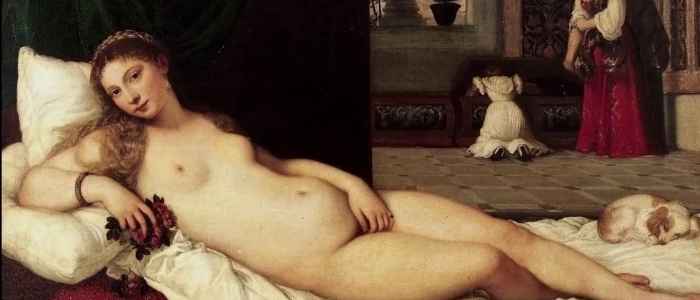
In the 20th century –after the artistic revolution of Impressionism and with the advent of paintings that explicitly display the artists’ subjective perceptions of reality– the (mis)representation of naked women shifted to a depiction of their appearance as threatening and disturbing. Paintings of female nudes, in this context, express feelings of fear and loathing. Picasso’s Les Demoiselles D’Avignon (1907) is a clear example of this, as the naked prostitutes painted on the canvas seem menacing, their bodies structured under the influence of Primitivism. Feminist interpretations of the painting, such as in Carol Duncan’s “Virility and Domination in Early Twentieth-Century Vanguard Painting” (1973), argue that the way in which Picasso depicts the female subject is exemplary of gender relations before the First World War, as the women embody both the dangerous femme fatale and the primitive woman, thus becoming both threatening and powerless.
Within this context, some painters approached the subject of the female nude in a different way, contributing to its emancipation. Manet is certainly one of them. In the period that experienced the birth and development of Impressionism, the artist challenged conventions of representation when he first exhibited his masterpiece: Olympia (1863). The young woman in the painting shares the same pose of the Venuses mentioned above, but, at the same time, she draws attention to her non god-like appearance, since her necklace, black cat and shoes explicitly suggest that she is a prostitute. Manet here is not yet emancipating the woman from her status of passive object to look at, but he is unmasking the nature of artistic female nudes. Olympia is a statement, attempting to make us aware of the voyeuristic nature of art. She is a scandal to the tradition, explicitly displaying her sexuality, staring back at the viewers that are supposed to look at her, unseen.
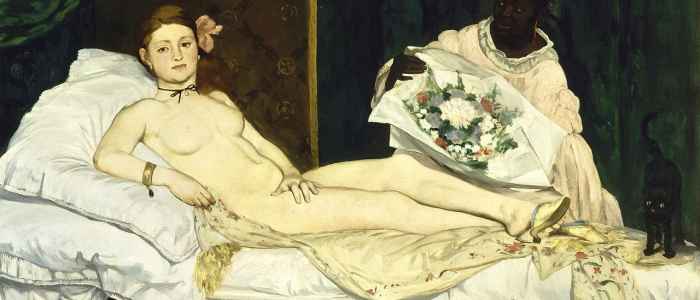
Following Manet, from the late 19th to the 21st century, various painters have depicted the female nude in a way that disempowers the tradition of idealization and objectification of women. Artists such as Schiele, Bacon and Freud, portray nude subjects that, far from being idealized sexual objects for men, disrupt the conventional display of female bodies and offer the viewers new ways to look at them.
Gauguin and the Tahitian Women
Paul Gauguin is one of the most famous Post-Impressionist painters. He is considered to be the precursor of the Fauvist movement, with its peculiar and unconventional use of color: in his paintings, the use of colour is highly subjective, linked to the emotion that the subject inspires rather than the subject itself. Gauguin’s most striking paintings are the ones from Tahiti, which the artist visited first, and then permanently made his home, longing for a paradise in which he could create a pure and primitive art. In this period, he focused on the depiction of Tahitian landscapes and native women.
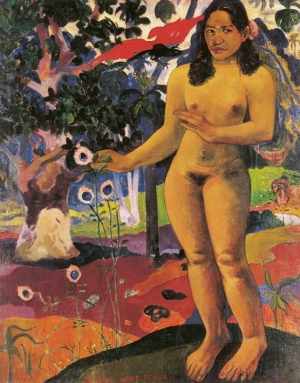
In The Delightful Land (1892), for instance, the artist painted a naked Tahitian Eve in the Garden of Eden. The image of Eve, a standard in the western tradition, is in this case portrayed in a way that disrupts the 19th century western ideals of beauty, as she has dark skin, body hair, thick thighs and big feet with seven toes on the left foot. Her shoulders are broad and her face is graceful in a way that the western viewers of the time would have defined as primitive. However, Gauguin presented this new and diverse depiction of the female nude as equally beautiful compared to the traditional. Another interesting example of Gauguin’s representation of naked Tahitian women is Hannah the Javanese (1893), in which the painter foregrounds the proud pose of the subject, her awareness of the male gaze and, even more importantly, the real nature of her beauty. There is nothing divine about her pose and gaze, just like in Manet’s Olympia. Interestingly Manet’s work was one of the main inspirations for Gauguin, especially for his Manao Tupapau (Spirit of the Dead Watching, 1892), in which a Tahitian woman lies down on her stomach, naked and aware of the spirit that spies on her from behind.
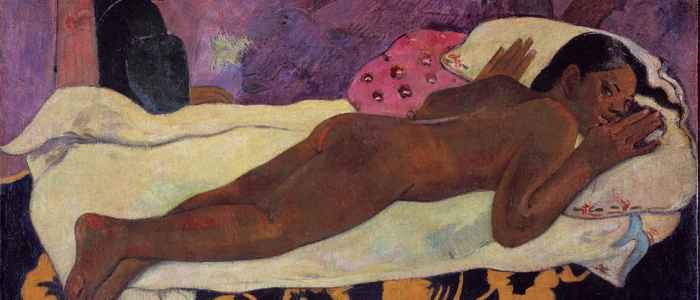
Schiele and the Erotic Nudes
At the beginning of the 20th century, while Egon Schiele’s fellow painters were depicting women as threatening, he foregrounded their beauty and sexuality. Schiele completely rejected traditional depictions of women in stereotyped positions, and instead experimented with female portraits in various postures and with different body shapes.
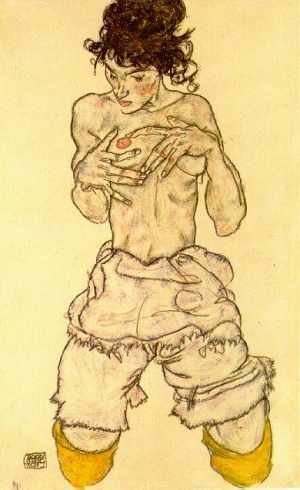
Sigmund Freud’s influence on Schiele is significant: while the painter was studying in Vienna, the psychoanalyst was publishing his groundbreaking work, Three Essays on Sexuality (1905). Twentieth-century Vienna, where Schiele lived, was experiencing obsessive discussions about sex, which paradoxically spread in an atmosphere of respectability where sexuality was related to castration, rejection, refusal and hiddenness.
In his depictions of the female nudes, Schiele brings to the fore this unhealthy and suppressed sexuality, portraying bodies that are consumed by uneasiness and by marks of sinful transgressions. The distortion of the human features shows the effects of social condemnations on them, as well as it mirrors the individuals’ troubled inner experiences, caused by an exhausting external and internal surveillance.
Woman touching her breast (1910) is a powerful example of this struggling sexuality. The woman here explicitly displays her sexuality, seemingly without shame. However, the shadows of black and pink on her body seem to suggest her inner conflict as well as society’s condemnation of such a free erotic behaviour. Other female nudes by Schiele that explicitly display the aspects mentioned above include Woman with Black Stockings (1913), Female Nude on her Stomach (1917), and Girl with Black Hair (1910).
Modigliani and the Reworking of Convention
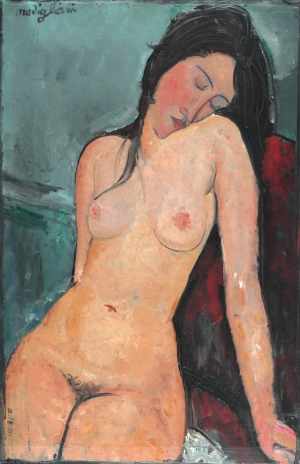
The Italian painter Amedeo Modigliani is known for his portraits and nudes whose style is distinguished by elongation of figures as well as blank eyes –the artist famously claimed: ‘When I know your soul, I will paint your eyes’. His works, which include a broad number of nudes, such as Reclining Nude (1917), Nu Couchè (1918) and Nude on a Blue Cushion (1917), were not received well during his lifetime.
His Female Nude (1916) is a radical reworking of the conventions of figurative painting and sculpture in western European art. The graceful pose and expression of the sleeping model, her eyes closed, her head resting on her shoulder are typical of the tradition of classicist nudes. However, the woman’s face and its simplified features also recall non-western art, bringing to the fore Modigliani’s interest in and knowledge of Egyptian, African and Oceanic sculpture. The painter mixes conventional elements of the Western art with unconventional elements of other artistic cultures and, as a consequence, this painting was condemned as a challenge to the tradition of European art. The element that was specifically considered shocking by the art galleries of the time was Modigliani’s explicit depiction of pubic hair in his nudes, which was a well-known a taboo in Salon paintings. For this reason, the painter’s exhibition at Berthe Weill’s gallery in 1917 was closed on grounds of indecency.
Bacon and the Aggressive Sexuality
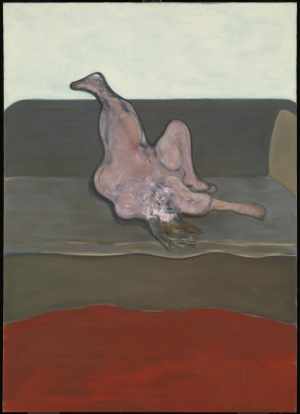
Francis Bacon is famous for his representation of body and face distortions that emanate a feeling of uneasiness and conflict. His portraits exasperate the disruption of facial features, as if they were suggesting the difficulty of a unified Self in an era of conflicts and contrasts.
The artist’s approach to the nude is even more interesting. Bacon especially focused on male nudes in order to challenge the phallocentric tradition that dominated art. However, in his work Reclining Woman (1961), he selects a female subject. Bacon depicts the woman as lying down in a confident and almost aggressive position. In this case, the female nude is clearly not an object to look at for the male gaze, as it is blurred and unclear. It is not reassuring but, on the contrary, it challenges the viewers, displaying a confident and aggressive subjective sexuality, which makes her, rather than an object of sexual desire, an embodiment of it.
Freud and the Plus Size Models
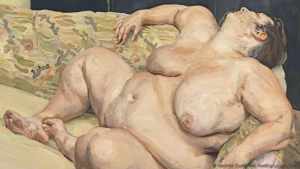
Lucian Freud’s Benefits Supervisor Resting is part of a series the painter started in 1993. The extreme realism, the unconventional beauty and the erotic quality are all significantly brought to the fore by Freud’s technique. Freud not only goes against the tradition of the artistic representation of the female nude, but he also defies the contemporary obsession with stereotyped beauty and skinny models that characterize contemporary fashion, adverts and magazines.
The woman he portrays in Benefits Supervisor Resting references a more ‘ancient’ beauty, typical of the primitive societies whose artifacts always depicted beauty in association to abundance and fertility. The Venus of Willendorf is an example of these artifacts. The statuette of the female figure, found in Austria, and probably made around 26,000 BC, was a symbol of fertility and childbearing, if not even a goddess. It is interesting to point out how a current tendency in fashion is the ‘plus-size models’, such as Ashley Graham, who contribute to the progressive emancipation of the stereotyped feminine image.
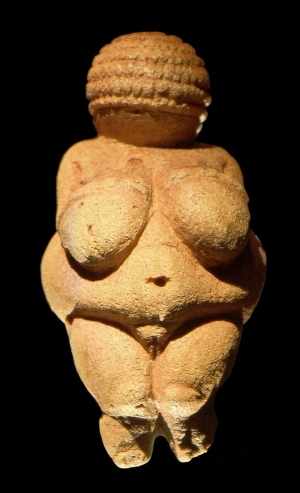
Thomas and the Female Emancipation
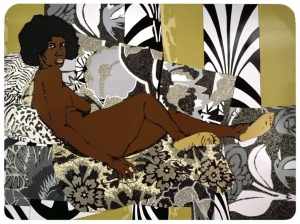
Mickalene Thomas is the only woman among the painters mentioned in this article. The contemporary African American painter from Brooklyn embodies a big step forward towards the liberation from conventions about the female representation, creating paintings that empower instead of weakening the female nude. Thomas’s paintings, photographs, and collages display varied ideas of beauty, race and femininity —real women with different body types, ages and hairstyles who exude a strong sense of confidence and elegance.
Thomas especially explores and asserts the complex identity of black women within Western tradition that, for centuries, had privileged the ‘idealized’ white female nude as protagonists. To do so, in A Little Taste Outside of Love (2007), she explicitly draws attention to the pose of her subject, which is a reference to the iconic paintings by masters such as Ingres –in this case, the subject painted by Thomas recalls Ingres’s La Grande Odalisque (1814)–, criticizing the lack of black women within visual western culture, while also asserting their empowered presence in the same spaces from which they were previously excluded.
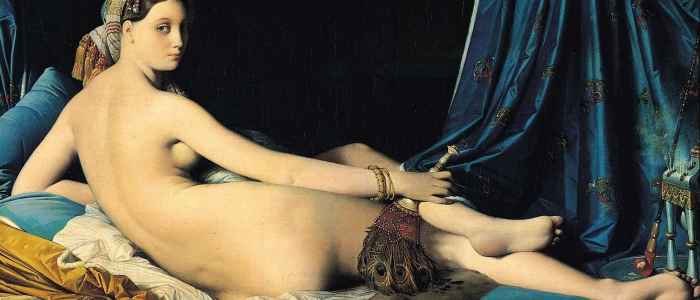
Works Cited
1. Beth Harris and Steven Zucker, “Manet, Olympia.” Khanacademy.org, (n.d.).
2. Carol Duncan, “Virility and Domination in Early Twentieth Century Vanguard Painting”, in Feminism and Art History: Questioning the Litany, by Norma Broude and Mary D. Garrard (New York: Harper & Row, 1982), pp. 304–305.
3. Jonathan Jones, “Egon Schiele: The Radical Nude Review – a feminist artist ahead of his time.” The Guardian, (Oct. 2014).
4. Alastair Sooke, “Lucian Freud and the Art of the Full Figure Nude.” Culture, (May 2015).
5. “Bio.” Mickalenethomas.com, (n.d.).
What do you think? Leave a comment.











My personal favorite is Sleeping Nude with Arms Open by Modigliani.
I adore Modigliani!
Mine is La Maja Desnuda by Goya.
Titian intended his painting for more than just pleasure to the viewer, but to demonstrate the beauty of the human body. Not in a sensual manner.
I absolutely agree! Yet, I also believe he was inevitably part of a patriarchal tradition that depicted women in a certain stereotyped way!
I love the direct gaze in Titian’s Venus of Urbino.
The paintings are very interesting and all the different things to notice and draw from really do lend to the intrigue of the subject and what is going on there and her intentions.
Thanks for your comment!
Such an interesting article! Thank you for posting it
Thank you for reading it!
Major thankies for the article post.Really looking forward to read more. Really Great.
thanks you very much! I appreciate it!
Bodies and perception! An area of research that is getting a lot of play lately. Should be interesting to see where we go with this and a great way to start is where we have been in the past on this issue. Thanks for an informative read.
Yes, the issue is getting a lot of attention, and I am glad you found the reading informative!
Great article! I really enjoyed reading it, it got me to thinking about how feminine nude in art has changed during last centuries, and the story goes together with the emancipation of women. Thanks for posting!
Drawing a parallel between the evolving representation of the female nude and the emancipation of women was definitely supposed to be an undertone of the article! Thank you for picking up on it and reading the article!
Giorgione was actually reviving a tradition of the female nude that can be traced back to ancient Greek art.
Congratulations! An impressive article about art and women.
The Venus of Willendorf testifies how much this theme is radicated in the artists’ imagination.
Thank you for your comment! and yes the Venus of Willendorf is a great embodiment of how the artist’s subjectivity can shape his work!
It’s very interesting to see how art has changed over the time on representing women characters. I wonder what the future representation will be… Any ideas?
Considering that art itself is radically changing –so much, in fact, that nowadays it is often hard to define it– I am sure that with the evolution of form, also the content of representation will be very different! Just like men have offered various depictions of women over the centuries, I am now curious to see how women will represent themselves! Thanks for your comment!
I have a print of Modigliani Seated female Nude. It is a pencil sketch. The model has dark hair and there are 3 candles on a shelf to the right of the model.
This is great for my art appreciation course in college.
Glad you liked it!
Gauguin remained forever a child of the 19th century!
In The Venus of Urbino, I see that this painting is purposefully sensual and she is definitely not ashamed of her nudity. She is looking directly at the view, projecting desire.
I found myself drawn to the small sleeping dog at the end of the bed and the symbolism it portrayed. I have read that a dog generally symbolizes faithfulness and the fact that this one is sleeping could show that she is unfaithful.
Thank you for your comment! And yes dogs can be symbols of fidelity! In this specific case, I’ve read that the portrait was given as a gift by the Duke of Urbino to his wife, in order to ‘teach’ her fidelity. Therefore you could potentially read the entire symbolism of the painting –dog included– as educational for the viewer!
The male equivalent to Titian’s Venus of Urbino would be Michelangelo’s David.
Interesting point!
Interesting picture of female portraits, is there enough material to create a similar article of male portraits?
I think you could definitely explore the ways in which men have portrayed themselves (and that would clearly be an interesting topic), but historically it would be hard to find numerous male portraits by female artists. I find it interesting that when women started painting (or at least, not in secret anymore), they were more concerned with the representation of their own sex (see for instance Frida Kahlo)
It’s impressive how naked female representation has changed over the years…. Thank you for mentioning Gauguin and his unique use of colors.
Great article!
I’m glad you enjoyed the article! Thank you for your comment!
I’ve never been a Gauguin fan when it comes to his paintings but for me, his prints have real substance, almost none of the sentimentality of his paintings.
I’ve seen many of Gauguin’s prints at a MOMA exhibition, and I also enjoyed them very much. However, I believe that Gauguin’s use of colors communicates in ways that can still profoundly affect the viewer.
I enjoyed reading your article, you have completed a thorough analysis of the paintings and have tied it in well with the topic.
Thanks you very much!
Are these paintings erotic? (serious question)
Good question! I wouldn’t say all of them are, and eroticism was not one of the main points I wanted to make in the article. I believe Schiele features a lot of erotic poses in his paintings, as a way of freeing the body from the linguistic and formal oppression that sex was experiencing. I also think Bacon is interested in erotic painting in a way that deals with identity and sexuality. For the other paintings, I don’t think there is necessarily an explicit connection between the nude and eroticism.
Maybe that is for the individual observer to decide.
The Venus of Urbino is strikingly beautiful, youthful, and erotic.
The evolution of female nude paintings is really fascinating. Modigliani’s Female Nude remains my favourite one, but thank you for sharing your interesting point of view on all the other paintings and in particular for highlighting Thomas’s work.
I really appreciated reading this article and I look forward to reading more!
Thank you for your comment! Looking forward to writing more!
Very interesting article !
I admire Gauguin, inspires me about courage. The courage of seeing things in a different matter.
Also amazing Freud and his plus size paintings…I am not sure if it was somekind of “provocation”…more than emancipation.
Maybe provocation for emancipation?
I’ll be waiting for the next article !
I like your idea about provocation in relation to the need for emancipation! Thank you for your comment!
Very interesting article, that illustrate an innovative point of view
Thank you!
Modigliani… such an original and beautiful style from a painter with such a tragic life.
He’s one of my favourites! Yet, he was not very famous during his life!
The clear distinction between the binary contrast of male and female still influences our sexual politics today.
It does, but I feel like contemporary art has blurred, to an extent, such distinction!
Who would have thought that artists were already making such bold statements about body perception during such an early era. Frankly, had no clue but I love the variety of messages of each painting. My favorite is the unconventional native women
I feel that paintings are always necessarily influenced by the context in which they are produced. And yes, the diversity of these representations of the female nude is definitely interesting! Thank you for your comment!
Excellent article. Now I would like to see you broaden your perspective to trace the evolution of sculpture of the female figure from the Greek idealized forms onward.
That would definitely be an interesting and significant topic worth thinking about! I personally love Greek art! thank you for your comment and suggestion!
The Greeks were more into the male body, weren’t they?
What are anybody’s thoughts about the role of the male gaze?
There is a very interesting article written by Laura Mulvey that tackles the issue of the male gaze in Hollywood cinema employing psychoanalysis. I’m not completely sure you could apply that to these paintings, but it makes some interesting points that are definitely relatable to how women are portrayed in art.
I liked how in depth your analysis was. It got me to notice different things.
Thank you!
Are the women elongated proportions not mannerism already.
Excellent article. Made me look things I knew from a different point of view and discover new ones through a profound and accurate analysis. Good job!
Thank you very much!
I’m interested in how the juxtaposition of the very dark skin of the servant with the brightly white skin of Olympia contributes to the meaning of the painting. Is it possible that Manet’s presentation of harsher truths about sexuality and questions about the nature of our “looking” at such figures includes the black female servant intentionally? If this is a painting that is as much about painting as it is about the nude?
Good question! The presence of the black servant definitely says something about the time!
Giorgione’s painting of a nude woman marked a revolution in art and some art historians believe this painting marked one of the starting points for modern art.
A beautiful woman’s glance is a traditional weapon.
Intersting article! I never thought how political displaying the female body could be. Are there as many political connotations to depicting the male body in various forms? And if not, what does that say about us as a society?
I think it would have been interesting to include a few examples of the “female nude” outside just painting as well. Especially comparing ancient works (all clearly labeled as mythological to avoid controversy) to the overtly sexual narratives of artists working today, in sculpture especially. Also in regards to photography as well; upon its invention it was almost immediately used for pornography. Endless avenues to go down when dissecting art from a feminist narrative!
I agree I actually thought of including sculpture and ancient works but I did not want to make the topic too broad so I decided to focus on paintings only!
Interesting read, thank you for composing this. I get from this that a woman can be nude, and powerful in art.
I’m glad you liked it! Thanks for your comment !
Beautiful article! It is so interesting to see how the boldness of the painting style mirrors the boldness of the woman in the painting.
Thank you very much!
Really interesting article. I would add that there is something to be said for the fact that so many of these paintings play on the viewer as the subject being viewed, leading to the question of revelation versus interruption. Thomas’s painting seems to be angry in its use of color, expression, and medium in a way that Titian’s Venus is not, a fact that is reinforced by the woman revealing her arm in the background and the semi-public setting. Titian’s Venus of Urbino seems to say we are given a revealed image, something echoed in the other featured artists’ paintings. They place their women in domestic settings, traditionally placed controlled by women, with even prostitutes representing a version of this, though perhaps presented in a way that reveals the growing unease in how women are perceived and in their changing roles in society. Perhaps Thomas and even, to an extent, Schiele’s women touch on true liberation of the female figure. Their women exist outside of the male gaze, they are not passive creatures allowing themselves to be seen. Rather Scheile’s seems perhaps conflicted but nonetheless boldly exploratory outside of the need or desire for a man’s touch or gaze, and Thomas’s woman glares at us, sharply confronting and shaming our gaze.
Sorry its such a long comment!
Thank you for your great comment! Yes, the viewer is, paradoxically, viewed, and I believe this is one of the reasons why these paintings manage to put their subjects in such a powerful position. As you said, Thomas’s painting is a particularly powerful example of this. However, I’m not sure Schiele’s women are fully free. Rather, they express the pain and unease of the male gaze!
Exposing women nudity via art shows balance of power within social affiliation and dogmas presented in the cosmic world.
Freuds depiction of extreme realism in his piece, spot on for the times!
Nudity is in the eye of the beholder… I remember my art teacher showing us Titian’s Venus vs. Manet’s Olympia as examples of “nudity” versus “nakedness”; nakedness being purposeful. As long as the woman a) distanced from mortal/current women and b) seeming to not participate consciously in the nude scene created, she is allowed. I asked another art teacher how Victorians could view and value some of the statues and art they did when they discouraged acknowledgement of such topics in contemporary culture, and she basically shrugged and said masterful sociological cognitive dissonance.
It is interesting to view the different observations and representations of women through history. Great insight and depth in your article!
Thank you! I’m glad you enjoyed reading it!
Amazing perspective on the female nude that I’d never really considered before. This was a wonderful read, thank you!
Thank you for your comment! I’m glad you found the article useful!
Thank you for the overview in this article! I didn’t know a lot about this topic but I’m now hella intrigued on representation of women in this art form. Fascination with the female nude is so peculiar to me considering the apparent lack of male nudes by female artists. Or perhaps I’m speaking from a place of ignorance?
Interesting point! I’ll definitely do some research about male nudes by female artists!
lol male artists reinventing the female nude- ermmm what about women artists? women representing women? Is men showing the female nude women YET AGAIN really reinventing the female body? Manet’s olympia a highly sexualised image that takes influence from Oriental art showing women as just sexual beings really again reinventing women? How on earth is this emancipating women?
As you can see in the article, I have included a female painter (Thomas). All the other painters I have considered are men because of the centuries in which they worked (a period in which female creative emancipation was not yet there). However, looking at contemporary painters, many women are offering reinterpretations and more authentic representations of the female body (see Nina Abney, Tschabalala Self, Alejandra Hernandez etc).
I particularly like the last paragraph, the only one about a female painter. It seems like a quick teaser the next installment that could explore more deeply how women artists have been and are currently utilizing their art to speak about the female nude. It would be great to hear more.
Absolutely! I’m glad you liked it and thanks for your comment
What a fascinating article! I hope we can expect more to come!
Point is, temporary mind level dimensions such as idea flash, recalled imagination, experienced inspiration and wandering dream be in permanent position; through a medium. Rest are contextual and situational evolution of visual representation of narrative. Nonetheless, that makes an art it’s identity.
Titian’s Venus d’Urbino did not embody the traditional concept of the female nude. The dominant concept of the female nude presented the figure… the woman as passive… an object of beauty who averts or closes her eyes so that the male viewer may ogle her comfortably. Titian’s “Venus” is an active participant. She stares back at the viewer… appraising him as he does her. This engagement made many male viewers uncomfortable. Mark Twain famously wrote on the Venus d’Urbino calling it the most vile and vulgar painting in existence. Manet’s Olympia built on Titian’s painting shocking the sophisticated male art viewers who could accept the Venus d’Urbino as it was cloaked in the perfume of history… but could not stomach the contemporary sexually-aware woman looking back at them. Intriguingly… American pinups… whether we speak of the paintings of the 1930s-1960s by artists like Zoe Mozert, Gil Elvgren, or Vargas… or Playboy centerfolds… are often far more active and engaged: standing and confronting the viewer with their gaze.
It’s holy
Hey it’s beautifully written
A good essay. I enjoyed it, always nice to learn about something I know little about.
This article reminds me of the article on the Art Institute of Chicago’s website called Women on the Walls which has a very interesting take on women, in general, in paintings. I partially enjoy the perpective that you have on the subject!